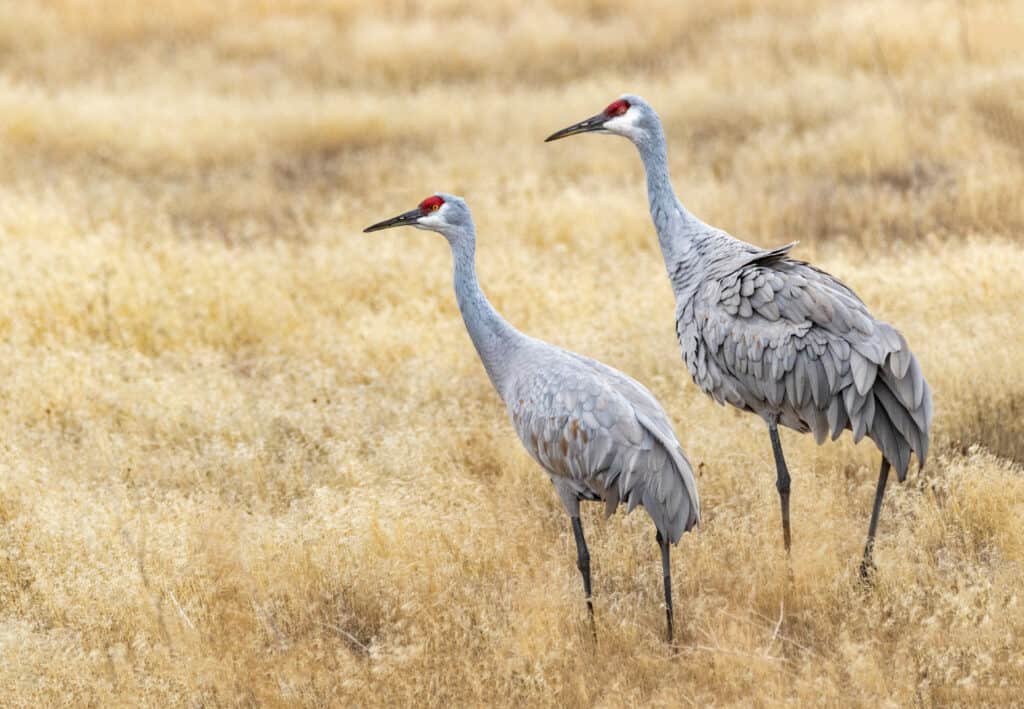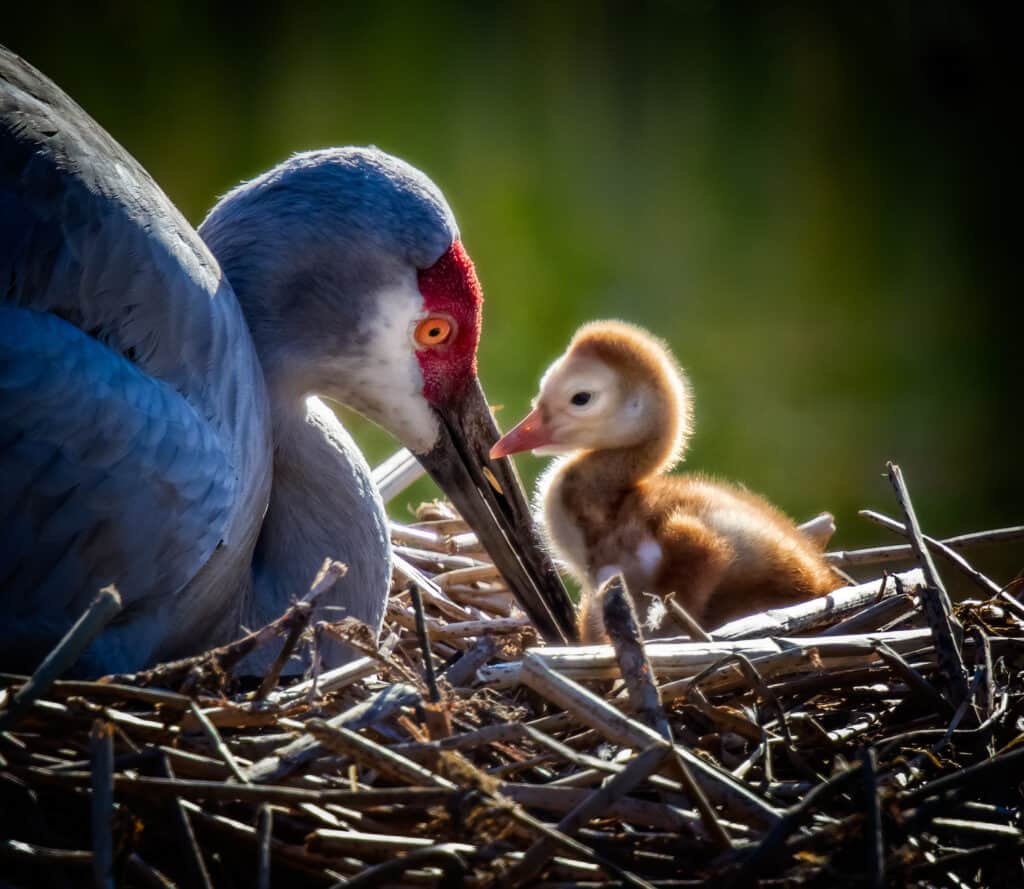Did you know that even National Geographic has called the migration of sandhill cranes one of “North America’s greatest wildlife phenomena?” Sandhill cranes remain gorgeous, gentle creatures who carve out a quiet existence in most of North America.
Learn more about sandhill cranes, their nesting behavior, and where to see their stunning migration and nests.
A Brief Sandhill Crane Summary

You can see sandhill cranes in much of North America, depending on the month.
©Benjamin Tillotson/Shutterstock.com
Sandhill cranes, or Antigone canadensis, have an interesting appearance and dazzling migratory process. These birds stand between three and four feet high – similar to a blue heron. However, the sandhill crane remains considerably more “bulky” than the blue heron. While a blue heron weighs around four or five pounds, sandhill cranes can weigh as much as 11.
A sandhill crane’s wingspan averages 78 inches, or between five and six feet long. This massive wingspan gives them the power they need to complete their yearly migration of 5,000 or more miles.
These gorgeous birds are monogamous and mate for life. They’ll lay a clutch of one to two eggs a mating season. After birth, the hatchlings can almost immediately walk around and follow their parents out of the nest.
When it comes to food, sandhill cranes are omnivorous and opt to enjoy fruits, seeds, grains, and small insects. Unlike blue herons, they do not fish.
The species of sandhill cranes contains several different subspecies; some of which are endangered. Those species include:
- Lesser sandhill crane, (A. c. canadensis)
- Greater sandhill crane, (A. c. tabida)
- Canadian Sandhill Crane, (A. c. Rowani)
- Florida sandhill crane, (A. c. pratensis)
- The endangered Cuban sandhill crane, (A. c. nesiotes). This is a non-migratory subspecies.
- The endangered Mississippi sandhill crane, (A. c. pulla). This is a non-migratory subspecies.
Sandhill cranes used to be considered part of the Grus genus, but changed to Antigone after extensive research in the 2010s.
The Migration of Sandhill Cranes

Sandhill cranes are monogamous birds.
©Michael Chatt/Shutterstock.com
Of the sandhill crane subspecies in North America, only two choose not to migrate (the Cuban and the Mississippi sandhill cranes). The others all migrate throughout the year, using a particular stop-over point mid-way through their journey.
Nearly 80 percent of all the North American migratory sandhill cranes visit a 75-mile stretch of Nebraska’s Platte River in March and April. As many as 500,000 birds fill the narrow area. They all use this time to prepare themselves for their northern journey to breeding spots in the Pacific Northwest, Alaska, and Canada.
Sandhill Crane Habitat Preferences

Sandhill crane nests are large and placed on the ground or standing water.
©jo Crebbin/Shutterstock.com
These avians prefer to live in wetlands for most of the year. When mated, sandhill cranes will build large nests over shallow water or on dry land near a water source.
Both partners will build the nest, though it’s usually the female who arranges the material into a nest of her liking. The nest, composed of cattails, reeds, grasses, and twigs will range in height between four and six inches. To account for the birds’ large wingspan and body, sandhill crane nests average between 30 and 40 inches in diameter.
Where Do Sandhill Cranes Nest?

Young sandhill cranes can walk, eat, and hunt with their parents almost immediately.
©iStock.com/Bkamprath
Sandhill cranes nest in the summer for breeding. Many of them choose the boreal forests of Alaska and Canada, so long as they’re within around 300 yards of a wetland or water source. Depending on the weather, species, and specific region chosen, sandhill cranes will opt to nest in a variety of places, including:
- Marshes.
- Bogs.
- Open grasslands.
- Forests.
- Freshwater ponds.
Researchers haven’t discovered if the male or female chose the nesting site; they’ve only found that a couple will return to the same spot (or its general vicinity) year after year to mate. Even if a mate dies, the remaining bird may return to the spot with their new mate.
During the winter months, you can see sandhill cranes in their preferred habitats in states like California, Texas, and Florida. After migrating through Nebraska, Colorado, New Mexico, Montana, Illinois, and Indiana, you’ll probably only see sandhill cranes in Alaska during the spring and summer breeding season. The fall brings sandhill cranes on the reverse journey.
Sandhill Crane Nesting
Sandhill cranes remain beautiful, intelligent creatures with an impressive ability to fly and particular nesting preferences. In the spring, the massive migration to breeding sites brings hundreds of thousands of sandhill cranes to Nebraska before they reach their final destination: the forests, wetlands, or marshes where they’ll build their nest and reproduce.
The photo featured at the top of this post is © Benjamin Tillotson/Shutterstock.com
Thank you for reading! Have some feedback for us? Contact the AZ Animals editorial team.







